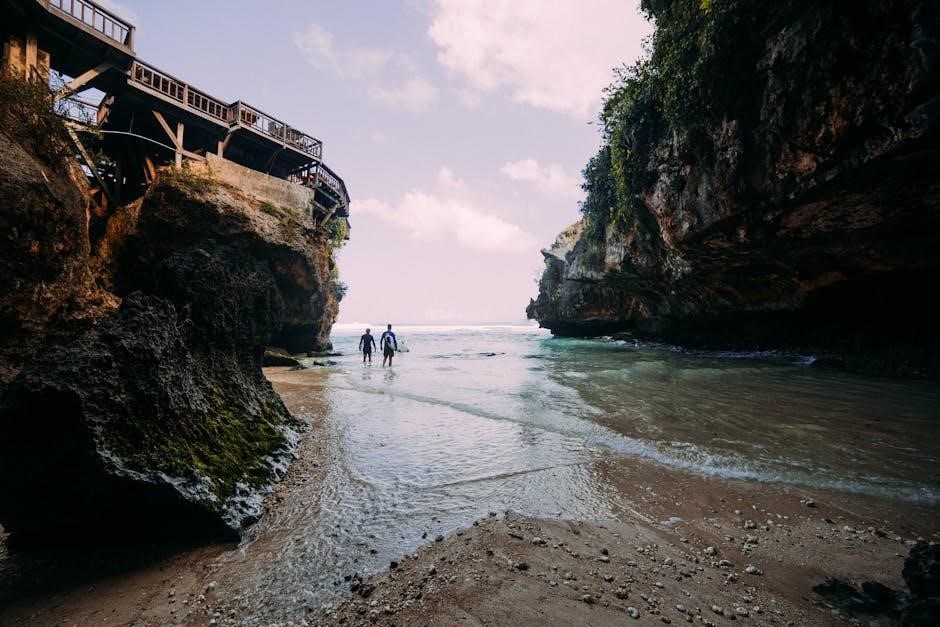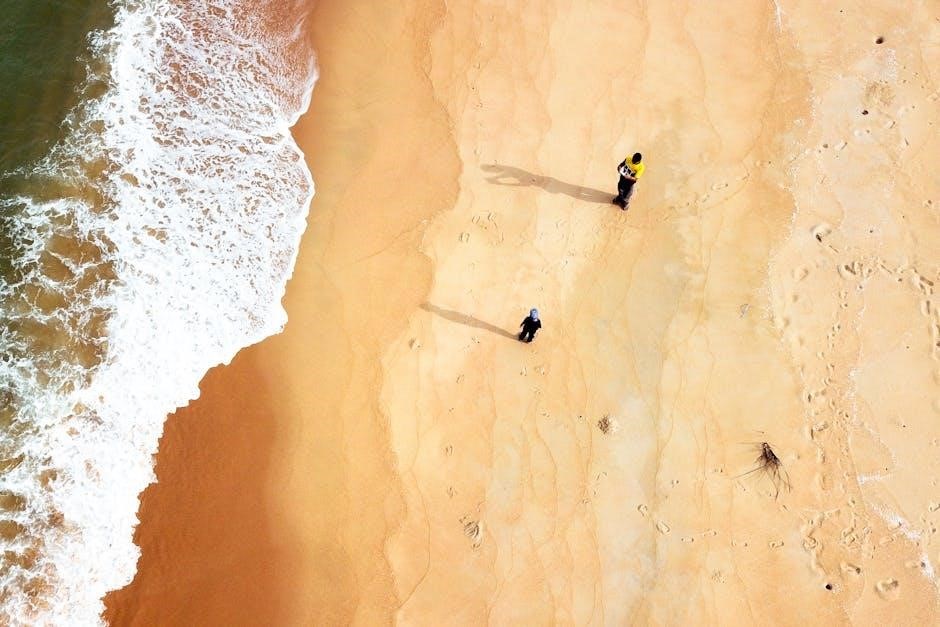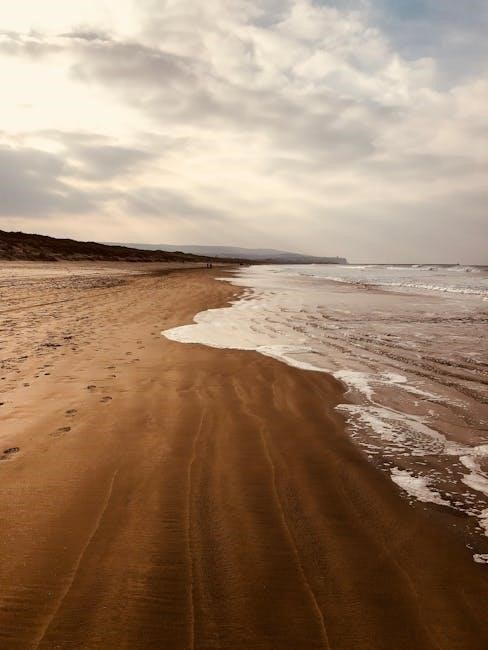Self-Guided Bay of Fires Walk
The Bay of Fires Walk offers a unique self-guided hiking experience‚ allowing you to explore pristine beaches‚ granite headlands‚ and stunning coastal landscapes at your own pace.
Location and Geography
The Bay of Fires Walk is situated on Tasmania’s north-east coast‚ stretching approximately 70 kilometers from Binalong Bay to Mt. William National Park. This pristine region is characterized by its dramatic coastal scenery‚ featuring white sandy beaches‚ crystal-clear azure waters‚ and towering granite headlands. The area is part of the Larapuna region‚ named by the Aboriginal community‚ and is renowned for its natural beauty and remote landscapes. The walk traverses through a diverse range of ecosystems‚ including forests‚ heathlands‚ and coastal dunes‚ offering hikers a unique opportunity to immerse themselves in Tasmania’s untouched wilderness.
Natural Features
The Bay of Fires Walk showcases a diverse array of natural features‚ including pristine beaches with white sand and clear waters. Granite headlands dominate the coastline‚ offering dramatic vistas and unique rock formations. The area is also home to dense forests‚ heathlands‚ and coastal dunes‚ creating a varied and picturesque landscape. Wildlife such as native birds‚ seals‚ and dolphins can often be spotted‚ enhancing the natural beauty of the region. The walk provides ample opportunities to experience these natural wonders up close‚ making it a must-visit destination for nature enthusiasts and hikers seeking a unique outdoor experience.
Cultural Significance
The Bay of Fires region holds rich cultural significance‚ named by Captain Tobias Furneaux in 1773 for its numerous Aboriginal fires. It is deeply meaningful to the Palawa people‚ who have inhabited this land for thousands of years. The area is steeped in Indigenous history and traditions‚ offering a connection to Tasmania’s First Nations heritage. Today‚ the Bay of Fires Walk allows visitors to experience this cultural landscape while respecting its history. The region also supports local wineries and cultural activities‚ blending natural beauty with cultural experiences that honor its past and present significance to both Indigenous and modern communities.
Planning and Preparation
Planning a self-guided Bay of Fires Walk involves selecting a 5-day itinerary‚ arranging eco-lodge stays‚ and ensuring early bookings for accommodations and tours.
When to Go
The best time to embark on a self-guided Bay of Fires Walk is during Tasmania’s spring (September to November) or autumn (March to May). These seasons offer mild temperatures‚ fewer crowds‚ and optimal hiking conditions. Summer can be busy‚ while winters are cool and wet‚ making the trails less accessible. Plan ahead‚ as peak season bookings fill quickly. Check local weather forecasts before your trip to ensure ideal walking conditions. Avoiding school holidays and peak tourist seasons can enhance your experience‚ allowing you to fully immerse in the serene coastal landscapes of the Bay of Fires.
Booking Accommodations
Booking accommodations for the Bay of Fires Walk requires careful planning due to limited options along the trail. Eco-lodges and camping sites are popular choices‚ offering a blend of comfort and immersion in nature. For self-guided walkers‚ pre-booking is essential‚ especially during peak seasons. Consider nearby towns like Binalong Bay or St. Helens for convenient stays before or after your hike. Ensure your accommodation aligns with your itinerary and physical needs. Research reviews and amenities to make informed decisions. Early reservations are recommended to secure your preferred option and avoid last-minute availability issues.
Necessary Permits
For the Bay of Fires Walk‚ securing necessary permits is essential to ensure a smooth and legal hiking experience. A valid Park Pass is required for entry into Mount William National Park‚ where the trail begins. Additionally‚ campers must obtain a Great Walks Pass if planning to stay at designated campsites along the route. Self-guided walkers should check with Tasmania Parks and Wildlife Service for any additional permits or fees. Failure to carry the required permits can result in fines or access restrictions. Always carry your permits with you during the hike for verification by park rangers or officials.
What to Bring
Essentials include sturdy hiking boots‚ trekking poles‚ layered clothing‚ rain gear‚ a map‚ GPS device‚ sunscreen‚ and insect repellent. Bring sufficient food‚ water‚ and a first aid kit.
Hiking Gear
For a self-guided Bay of Fires Walk‚ essential hiking gear includes sturdy‚ waterproof boots‚ breathable trekking socks‚ and lightweight poles for stability. A comfortable backpack with rain-resistant cover is crucial‚ holding layers of moisture-wicking clothing‚ a fleece‚ and waterproof jacket. Carry a hat‚ sunglasses‚ and sunscreen for sun protection. Navigation tools like a detailed map‚ GPS device‚ or smartphone with GPS app are vital. Ensure proper hydration with a water bladder or reusable bottles‚ and pack snacks like energy bars and trail mix for sustained energy. A first aid kit and emergency shelter are also recommended for safety.
Food and Water
When embarking on a self-guided Bay of Fires Walk‚ it’s essential to pack lightweight‚ high-energy foods like nuts‚ dried fruits‚ and protein-rich snacks. Bring a water bladder or reusable bottle to stay hydrated‚ as water sources are limited. Consider a portable water filtration system or water purification tablets to safely refill from streams. Plan meals in advance‚ opting for non-perishable items like freeze-dried meals or sandwiches. Don’t forget a portable stove for meal preparation. Always carry extra rations in case of delays and store food securely to avoid attracting wildlife. Proper food and water management ensures a safe and enjoyable journey.
Safety Items
Essential safety items for a self-guided Bay of Fires Walk include a first aid kit‚ emergency shelter‚ and a personal locator beacon (PLB). Carry a map and compass‚ as GPS signals can be unreliable. A headlamp or torch‚ extra batteries‚ and a multi-tool knife are also crucial. Pack a lightweight emergency blanket and whistle to signal for help if needed. Sunscreen‚ insect repellent‚ and a fire starter‚ like matches or a lighter‚ are important for comfort and safety. Always inform someone of your itinerary and expected return time to ensure help arrives promptly in case of an emergency.

Route Details
The Bay of Fires Walk is a 5-day‚ 45km journey along Tasmania’s stunning coastline‚ offering breathtaking views of pristine beaches‚ granite headlands‚ and iconic landmarks like Eddystone Point.
Trail Length and Difficulty
The Bay of Fires Walk spans approximately 45 kilometers over five days. The trail is moderately challenging‚ with a mix of sandy beaches‚ rock platforms‚ and gentle ascents. Hikers need a reasonable fitness level‚ as daily walks range from 7 to 10 kilometers. The terrain is well-marked‚ making it suitable for self-guided adventurers. While the walk is not overly strenuous‚ the uneven surfaces and varying conditions require attention. Proper footwear and preparation are essential to enjoy this rewarding journey along Tasmania’s stunning coastline.
Key Landmarks
The Bay of Fires Walk features iconic landmarks that highlight Tasmania’s natural beauty. The trail begins near the northern end of Mount William National Park and stretches to Binalong Bay. Key highlights include the dramatic coastal scenery at Eddystone Point‚ the historic lighthouse‚ and the vibrant orange granite rocks that give the area its name. Hikers will also pass through secluded beaches like Deep Creek and Cosy Corner‚ offering serene spots for rest. These landmarks exemplify the walk’s unique blend of rugged wilderness and coastal charm‚ making it a memorable journey along Tasmania’s northeast coast.
Day-by-Day Itinerary
The Bay of Fires Walk is typically a 5-day self-guided hike‚ covering approximately 45 km of stunning coastline. Day 1 begins at Mount William National Park‚ leading to the first campsite near the coast. Day 2 highlights the iconic Eddystone Point lighthouse and surrounding beaches. Day 3 explores the dramatic granite formations and secluded coves. Day 4 focuses on the southern section‚ ending near Binalong Bay. Day 5 is a shorter walk to the final point‚ offering a last glimpse of the Bay of Fires’ breathtaking scenery. This itinerary allows hikers to immerse themselves in Tasmania’s natural beauty at their own pace.

Safety and Precautions
Carry a Personal Locator Beacon (PLB) for emergencies. Monitor weather forecasts‚ as conditions can change rapidly. Store food properly to avoid wildlife encounters and stay on marked trails.
Emergency Procedures
In case of an emergency during the Bay of Fires Walk‚ activate your Personal Locator Beacon (PLB) if you have one. Contact emergency services via satellite phone or your GPS device. Stay calm and find shelter if weather conditions deteriorate. Ration food and water‚ and remain visible by staying on marked trails. If injured‚ assess the situation and seek assistance if necessary. Always carry a first-aid kit and know basic first-aid techniques. Stay informed about weather forecasts and avoid risky terrain. Ensure someone knows your itinerary and expected return time. Be prepared for isolation‚ as mobile reception may be limited in remote areas.
Weather Considerations
The Bay of Fires Walk is best undertaken in spring and autumn to avoid extreme weather conditions. Tasmania’s climate can be unpredictable‚ with sudden rain and strong winds possible. Always check weather forecasts before starting your hike and carry appropriate gear such as a waterproof jacket and sturdy footwear. Be prepared for cooler mornings and evenings‚ even in warmer months. Avoid hiking during heavy rain to prevent track erosion and ensure your safety. Stay informed about potential storms and adjust your itinerary accordingly. Keeping an eye on changing weather patterns will enhance your safety and overall hiking experience.
Wildlife and Environmental Considerations
The Bay of Fires Walk offers a chance to encounter unique Tasmanian wildlife‚ including native birds‚ seals‚ and dolphins. To protect this pristine environment‚ hikers must stay on designated trails and avoid disturbing vegetation. Keep a safe distance from wildlife and never feed them. Carry all rubbish out with you to maintain the area’s natural beauty; Be mindful of sensitive habitats‚ especially near coastal dunes and water sources. Eco-friendly practices are essential to preserve this fragile ecosystem for future visitors. Respect local regulations and leave the environment as untouched as you found it for others to enjoy.

Accommodation Options
The Bay of Fires offers accommodation options ranging from eco-lodges to camping sites and nearby towns‚ catering to various preferences and budgets for a comfortable stay.
Camping
Camping is a popular choice for those embarking on the Bay of Fires Walk‚ offering a chance to immerse oneself in nature. Basic campsites are available along the route‚ providing essential facilities like toilets and picnic tables. Campers can pitch tents in scenic spots‚ waking up to breathtaking coastal views. It’s important to carry all necessary supplies‚ as services are limited in this remote area. Camping allows hikers to fully connect with the environment‚ enhancing the overall wilderness experience. Be sure to follow park rules and leave no trace to preserve the pristine beauty of the Bay of Fires.
Eco-Lodges
Eco-lodges provide a luxurious yet eco-friendly option for those exploring the Bay of Fires Walk. These lodges are designed to blend seamlessly with the natural surroundings‚ offering comfort and sustainability. Many feature private rooms‚ shared facilities‚ and meals prepared using local ingredients. Eco-lodges are strategically located near key trail sections‚ allowing hikers to rest in style. They often include amenities like communal spaces‚ eco-friendly utilities‚ and expert guides. Staying in an eco-lodge enhances the Bay of Fires experience‚ combining adventure with relaxation and a commitment to environmental preservation. This option is ideal for those seeking comfort without compromising on sustainability.
Nearby Towns
Nearby towns like St. Helens and Binalong Bay offer convenient access to the Bay of Fires Walk. St. Helens‚ located just 10 minutes from the trailhead‚ provides essential amenities‚ including grocery stores‚ cafes‚ and equipment rentals. Binalong Bay‚ at the southern end of the walk‚ features charming accommodations and dining options. These towns are perfect for pre- or post-hike stays‚ offering a chance to restock supplies and enjoy local seafood. Their proximity to the trail makes them ideal bases for self-guided hikers‚ ensuring easy access to the Bay of Fires’ stunning natural beauty while still providing the comforts of small-town hospitality.

Transportation
The Bay of Fires Walk is easily accessible via nearby towns like St. Helens and Binalong Bay. Shuttles and car parking options are available for hikers.
Getting to the Start Point
The Bay of Fires Walk begins near Binalong Bay‚ Tasmania. Travelers can fly to Launceston Airport and drive 2.5 hours to the start point. Regular shuttle services connect nearby towns like St. Helens and Binalong Bay‚ offering convenience for hikers. Private car parking is available near the trailhead‚ with secure options for the duration of your walk. Public transport options are limited‚ so renting a car or booking a shuttle in advance is recommended. The start point is clearly marked‚ ensuring a smooth transition into your self-guided adventure along this stunning coastline.
Parking and Storage
Secure parking options are available near the Bay of Fires Walk start point‚ with designated lots offering safety for your vehicle during your hike. Shuttle services can transport you to the trailhead if you prefer not to drive. For self-guided hikers‚ parking fees are minimal‚ and some lots offer covered storage for added protection. Locker storage is also available at nearby towns like St. Helens for securing valuables. Ensure your vehicle is locked and valuables are out of sight. These convenient options provide peace of mind‚ allowing you to focus on your adventure along Tasmania’s stunning coastline.
Transport from Finish Point
After completing the Bay of Fires Walk‚ several transport options are available to return to your starting point or onward destinations. Shuttle services operate regularly from the finish point‚ offering convenient drop-offs at nearby towns like St. Helens or Binalong Bay. Private transfers can also be arranged for direct transport to your accommodation or other locations. Additionally‚ some tour operators provide hassle-free transport solutions as part of their packages. Ensure to book your transport in advance to avoid delays. These options make transitioning from the trail to your next destination seamless and stress-free.

Local Attractions and Activities
The Bay of Fires area offers stunning beaches‚ local wineries producing fine wines‚ and cultural activities that showcase the region’s rich heritage and natural beauty.
Nearby Beaches
The Bay of Fires is renowned for its pristine beaches‚ offering white sands‚ crystal-clear waters‚ and dramatic granite formations. Binalong Bay and the Gardens are highlights‚ providing secluded spots for swimming‚ sunbathing‚ or simply enjoying the serene coastal beauty. These beaches are perfect for relaxation after a day of hiking‚ with their untouched natural charm and breathtaking ocean views. Visitors can also explore hidden coves and enjoy photography opportunities‚ capturing the vibrant colors of the rocks and sea. The beaches are a must-visit for anyone exploring the Bay of Fires region‚ offering a tranquil escape from the hike.
Local Wineries
The Bay of Fires region is home to exceptional wineries‚ offering a taste of Tasmania’s renowned cool-climate wines. Local vineyards produce crisp whites‚ rich reds‚ and sparkling wines‚ benefiting from the area’s pristine natural conditions. Visitors can explore nearby wineries‚ such as those in the Tamar Valley‚ to sample award-winning wines and enjoy scenic views. Wine tastings and tours provide insights into the winemaking process and the region’s culinary heritage. Pairing a day of hiking with a visit to these wineries adds a delightful cultural and gastronomic dimension to your Bay of Fires Walk experience.
Cultural Activities
The Bay of Fires region offers a rich cultural experience‚ blending indigenous heritage and colonial history. Visitors can explore local art galleries showcasing works by Tasmanian artists‚ reflecting the area’s natural beauty. Historical sites‚ such as old lighthouses and Aboriginal rock carvings‚ provide insights into the region’s past. Community-driven events‚ like local festivals and markets‚ highlight the area’s vibrant culture. These activities allow walkers to engage with the region’s history‚ art‚ and people‚ adding depth to their Bay of Fires Walk experience and fostering a connection with the land and its community.

Health and Wellness
The Bay of Fires Walk promotes physical conditioning and mental well-being through immersive nature experiences. Proper nutrition and hydration are essential for maintaining energy levels during the hike.
Physical Conditioning
Physical conditioning is crucial for the Bay of Fires Walk‚ as it involves hiking up to 15 kilometers a day over varied terrain. Building cardiovascular fitness and muscular endurance through regular exercise is essential. Start training 8-12 weeks in advance with activities like brisk walking‚ cycling‚ or swimming to improve stamina. Strength training for the lower body‚ such as squats and lunges‚ can help with endurance on uneven terrain. Flexibility exercises‚ like yoga‚ can prevent injuries and enhance mobility. Ensuring your body is prepared will make the hike more enjoyable and reduce the risk of fatigue or strain.

Nutrition and Hydration
Proper nutrition and hydration are vital for a self-guided Bay of Fires Walk. Pack lightweight‚ high-energy foods like nuts‚ dried fruits‚ and jerky to maintain stamina. Include complex carbs and whole grains for sustained energy. Electrolyte-rich snacks and hydration tablets can help prevent muscle cramps and dehydration. Carry at least 2 liters of water per person daily‚ with a water filter or purification tablets as backup. Plan meals to balance protein‚ fats‚ and carbs‚ and snack frequently to avoid energy dips. Staying fueled ensures you can fully enjoy the hike’s breathtaking landscapes and challenges without fatigue or discomfort.
Mental Preparation
Mental preparation is key to a successful self-guided Bay of Fires Walk. Visualize the journey‚ set realistic goals‚ and embrace the challenge. Practice mindfulness to stay present and focused. Building mental resilience helps manage fatigue and unexpected obstacles. Reflect on past experiences to boost confidence and adaptability. Stay positive‚ as the stunning scenery will inspire and motivate you. A strong mindset ensures you can fully immerse yourself in the natural beauty of the Bay of Fires‚ creating lasting memories along the way. Proper mental preparation enhances your ability to enjoy the hike and connect with Tasmania’s unique wilderness.
Budgeting
Plan and manage expenses for the Bay of Fires Walk‚ including accommodation‚ food‚ and transportation. Self-guided tours often reduce costs compared to guided options.
Cost Breakdown
The Bay of Fires Walk self-guided tour involves several expenses. Accommodation costs range from $30-$150 per night‚ depending on whether you camp or stay in eco-lodges. Food and water supplies typically cost $50-$70 per person for the duration of the hike. Transportation to and from the trailhead‚ including parking‚ can range from $20-$50; Gear rentals‚ such as backpacks or hiking poles‚ may add $10-$20 daily. National park entry fees and permits are approximately $40-$60 per person. Overall‚ the total cost for a 4-5 day self-guided walk can range from $400-$700 per person‚ depending on choices and preferences.
Budget Tips
To save money on the Bay of Fires Walk‚ consider budget-friendly accommodations like camping or staying in nearby towns. Plan meals in advance to reduce food costs‚ and opt for self-catering options. Pack lightweight gear to avoid rental fees‚ and bring reusable water bottles to minimize expenses. Book during the off-peak season for lower rates‚ and take advantage of free resources like park maps instead of guided tours. Split transportation costs with fellow hikers and avoid unnecessary purchases. By planning ahead and making cost-effective choices‚ you can enjoy this stunning hike without exceeding your budget.
Payment Options
Payment for the Bay of Fires Walk can be made via credit or debit cards‚ bank transfers‚ or online payment platforms. Many tour operators offer flexible payment plans‚ allowing hikers to pay in installments. Some providers offer discounts for early payments or full upfront payments. Ensure to check with your service provider for specific terms. Secure online payment gateways are typically used to protect transactions. If opting for self-guided tours‚ verify payment methods for accommodations and permits. Keep receipts and confirmations for all transactions; Payment flexibility varies‚ so choose options that best suit your financial preferences and planning needs for a smooth experience.

Embark on the Bay of Fires Walk self-guided journey‚ immersing in Tasmania’s stunning coastal beauty. For deeper insights‚ explore detailed guides‚ join online forums‚ and read traveler reviews to enhance your adventure.
Final Tips

For a seamless Bay of Fires self-guided walk‚ plan meticulously‚ packing essentials like sturdy footwear‚ layered clothing‚ and a reliable map. Stay hydrated‚ carry sufficient snacks‚ and be prepared for unpredictable weather. Respect the environment by leaving no trace and adhering to local guidelines. Take time to absorb the pristine beaches and coastal scenery‚ capturing memories without disrupting nature. Ensure your itinerary aligns with your fitness level‚ and consider downloading GPS tracks for navigation. With proper preparation and mindfulness‚ your Bay of Fires adventure will be both rewarding and unforgettable.
Recommended Reading
For a well-prepared Bay of Fires self-guided walk‚ explore detailed guides and resources. Start with Tasmania’s official park websites for trail maps and regulations. Read blogs and travel articles highlighting the region’s natural beauty and hidden gems. Check out “The Bay of Fires Walk Guide” for insider tips on itineraries and accommodations. “Tasmania’s Coastal Treasures” offers insights into local ecosystems and wildlife. Download topographical maps for navigation and refer to “Self-Guided Hikes in Tasmania” for practical advice. These resources will enhance your understanding of the trail and ensure a memorable experience.
Community Resources
Engage with local hiking communities and resources to enhance your Bay of Fires self-guided experience. Join online forums and social media groups dedicated to Tasmanian hiking for firsthand insights and advice; Local Tasmanian hiking clubs often share detailed trail reports and safety tips. Additionally‚ connect with conservation groups involved in protecting the Bay of Fires region to gain a deeper understanding of its ecosystems. These resources provide valuable connections with experienced hikers and experts‚ ensuring a well-informed and enjoyable journey through this stunning coastal landscape;
